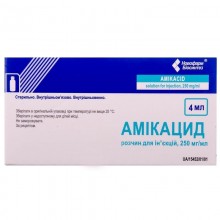



 Secure and encrypted payment processing
Secure and encrypted payment processing We ship to over 40 countries including the USA, UK, Europe, Australia and Japan
We ship to over 40 countries including the USA, UK, Europe, Australia and Japan Guaranteed refund or reship if you haven't received your order
Guaranteed refund or reship if you haven't received your orderAmikacid solution is indicated for the treatment of infections caused by strains of microorganisms resistant to other aminoglycosides that are sensitive to amikacin.
Active substance: amikacin;
1 ml of amikacin sulfate is equivalent to amikacin - 250 mg;
Excipients: sodium, sodium metabisulfite (E 223), sulfuric acid, water for injection.
Use amikacin intramuscularly or intravenously.
It is necessary to administer amikacin by intravenous infusion to adults and children using a volume of liquid sufficient for drip infusion within 60-90 minutes (at a rate of 50 drops in 1 min), and for newborns within 1-2 hours. The concentration of amikacin solution during administration should not exceed 5 mg / ml. Intravenous injection of amikacin must be carried out very slowly (within 2-7 minutes). A solution for parenteral administration should be prepared immediately before administration and used immediately after preparation.
The following solvents can be used for administration: 0.9% sodium chloride solution, 5% glucose solution, Ringers lactate solution for injection containing glucose (5%).
The drug is contraindicated for use during pregnancy and lactation.
The drug is recommended to be used with caution in premature and full-term infants, because due to the underdevelopment of the excretory system, the output of aminoglycosides can be lengthened, causing toxic effects.
The likelihood of developing side effects from the central nervous system and sensory organs such as drowsiness, impaired neuromuscular transmission, discoordination of movements, and dizziness should be taken into account.
It is possible that the drug and the nephrotoxic effect of the drug and signs of neuromuscular blockade appear, tinnitus, hearing loss, hearing disorders, skin rashes, headache, dizziness, chills, paresthesia, decreased renal function (before renal failure), respiratory depression or paralysis, toxic reactions (ataxia, urination disorders, thirst, loss of appetite, nausea, vomiting).
Treatment: to remove the blockade of neuromuscular transmission and its consequences - hemodialysis or peritoneal dialysis; anticholinesterase agents, calcium salts, mechanical ventilation, other symptomatic and supportive therapy. Amikacin should be reduced by continuous arteriovenous hemofiltration.
Nausea, vomiting, diarrhea, impaired liver function (increased activity of hepatic transaminases, hyperbilirubinemia), anemia, leukopenia, granulocytopenia, thrombocytopenia, vasculitis, arterial hypotension, headache, drowsiness, neurotoxic effect (muscle twitching, numbness, tingling sensations, tingling, epilation) , violation of neuromuscular transmission (respiratory arrest).
It is pharmaceutically incompatible with penicillins, heparin, cephalosporins, capreomycin, amphotericin B, hydrochlorothiazide, erythromycin, nitrofurantoin, vitamins B and C, and potassium chloride.
Store in the original packaging at a temperature not exceeding 25 ° C. Do not freeze.
Keep out of the reach of children.
Shelf life is 2 years.